Dioon facts for kids
Quick facts for kids Dioon |
|
|---|---|
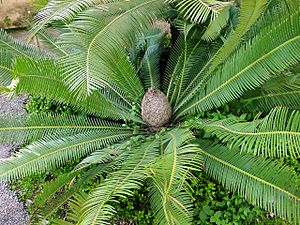 |
|
| Dioon edule | |
| Scientific classification |
|
| Kingdom: | Plantae |
| Clade: | Tracheophytes |
| Division: | Cycadophyta |
| Class: | Cycadopsida |
| Order: | Cycadales |
| Family: | Zamiaceae |
| Subfamily: | Encephalartoideae |
| Tribe: | Diooeae Schuster |
| Genus: | Dioon Lindl. |
| Type species | |
| Dioon edule Lindl.
|
|
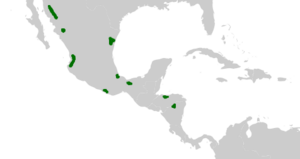 |
|
| Synonyms | |
|
|
Dioon is a group of ancient plants called cycads. They look a bit like palm trees but are actually very different! You can find them growing naturally in Mexico and Central America. They live in many places, from warm tropical forests to dry hillsides and even sandy coastal areas.
Contents
What are Dioon Plants Like?
Dioon plants are like palm-like shrubs. They have round stems and usually lots of leaves. Each plant is either male or female, meaning they have separate male and female parts on different plants.
These plants are perennial and evergreen, which means they live for many years and keep their leaves all year round. Their main stem is often partly underground. It's thick and made of soft wood. The leaves grow in a spiral pattern. The lower leaves often look like spines.
Dioon plants have 18 chromosomes in their cells.
The biggest Dioon species is D. spinolosum. It can grow over 16 meters (about 52 feet) tall! Its trunk can be as wide as 40 centimeters (about 16 inches). Other species are usually smaller, around one to two meters (3 to 6 feet) tall. Dioon plants can live for a very long time, possibly over 1000 years!
Dioon edule and Dioon tomasellii are found in the most places. However, most other Dioon species only grow in small, specific areas.
Dioon Leaves

Dioon leaves are made of many smaller leaflets arranged in pairs along a central stem. When they are young, some leaves are protected by special leaves called cataphylls. Unlike some other cycads, the young leaflets are straight, not curled. The lower leaflets often look like small spines. The leaf stalks are smooth and thick at the bottom.
The leaflets are simple and often have spiky edges. They don't have a clear middle vein like many other leaves. Instead, many small veins branch out from the leaf stalk and run towards the edges. Young leaves are usually hairy. These hairs are clear and can be branched or simple.
Tiny openings called stomata help the plant breathe. These are usually found on the underside of the leaves, but some species have them on both sides.
Dioon Roots
Like other cycads, Dioon plants can form special roots that look like coral. These roots grow upwards from the main root and branch out quickly just below the soil surface. These roots are home to tiny bacteria called cyanobacteria (specifically, Nostoc). These bacteria help the plant by taking nitrogen from the air and turning it into a form the plant can use. Dioon roots also seem to have a helpful relationship with special fungi called arbuscular mycorrhizal fungi.
Cones and Seeds
All Dioon plants are either male or female. This means a single plant will only produce male cones or female cones, not both.
The male cones grow on a stalk. Inside, they have small scales called microsporophylls. These scales are flat and bend upwards. They are arranged in a spiral around the cone's center. Each microsporophyll has many pollen sacs on its underside. When these sacs open, they release pollen. The pollen grains are smooth and have one germ line. Male cones usually fall off after about a year.
The female cones also grow on a stalk and can stay on the plant for more than a year. The female scales, called megasporophylls, look more like leaves than those of other cycads. They are flat at the top, wide, and bend upwards. Each scale usually carries two (sometimes three) ovules. These ovules hang downwards and are tilted inwards towards the cone's center. The tiny opening at the tip of the ovule is very small. The largest female cones, found on D. spinolosum, can be up to 80 centimeters (about 31 inches) long and 30 centimeters (about 12 inches) wide!
The seeds are round, oval, or egg-shaped, and they are about one to four centimeters (0.4 to 1.6 inches) wide. They are covered by a soft, fleshy, white or cream-colored outer layer. This outer layer has three parts: a soft outer layer, a hard middle layer of stone cells, and a soft inner layer. Inside the seed, the embryo is straight and has two seed leaves (cotyledons) that are joined at the top. The part that connects the embryo to the seed is very long and twisted. When the seeds sprout, the seed leaves stay inside the seed.
Where Do Dioon Plants Grow?
Dioon species are found in Central America, mainly between 15 and 29 degrees north latitude. Their distribution includes Honduras and parts of Mexico. Their growth areas are often limited by mountains and hills. Even though Dioon plants are found in many places and can adapt to different environments, they don't usually make up a large part of the plant life in those areas.
They grow mostly in tropical rainforests and wet tropical forests. You can also find them in tropical forests that lose their leaves, in forests with soft wood, on dry, rocky slopes, in deep valleys (canyons), and on sand dunes near the coast.
Dioon in the Past
Millions of years ago, at the start of the Cenozoic Era (about 65.5 million years ago), Dioon plants probably grew across most of North America. Fossils found in northern Alaska from the Eocene period (33.9 - 55.8 million years ago) show this. The climate was very warm back then. However, about 2.8 million years ago, the Earth started to get colder, and the North Pole froze. This caused the areas where Dioon plants could grow to shrink a lot.
During the Paleocene period (55.8 - 65.5 million years ago), Dioon was one of the few plant groups from Central and South America that also grew in Alaska. Over the Tertiary period (about 2.6 million years ago), Dioon plants disappeared from almost all of North America. Only a few small groups survived in Central America, which is where most Dioon species are found today. They couldn't spread to South America because the two continents weren't connected until about 3 million years ago. After that, the large size of their seeds made it hard for them to spread further into the Caribbean and South America.
How Do Dioon Plants Interact with Nature?
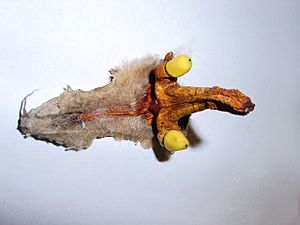
Scientists are still trying to figure out if Dioon plants are pollinated by wind or by animals. The pollen is light, dry, and produced in large amounts, which suggests wind pollination. Also, more seeds get fertilized when a pollen source is nearby.
However, the way the ovules are positioned (hanging inwards) makes it hard for wind-blown pollen to reach them. For other cycads like Zamia, weevils (a type of beetle) have been found to help with pollination. Weevils of the genus Rhopalotria have also been found in Dioon cones. Many beetles from the genus Pharaxonotha, which eat pollen, have also been found in Dioon cones. This suggests that animals might help pollinate Dioon plants.
Protecting Dioon Plants
The Dioon genus is in danger mainly because their natural homes are being destroyed. The International Union for Conservation of Nature (IUCN) lists ten out of the eleven species as being at risk. One species, D. caputoi, is considered critically endangered, which means it's very close to disappearing. Three species are endangered (D. holmgrenii, D. sonorense, and D. tomasellii), and five are vulnerable (D. califanoi, D. merolae, D. purpusii, D. rzedowskii, and D. spinulosum). D. edule is listed as "near-threatened." For D. mejiae, there isn't enough information to know how much danger it's in.
Their habitats are being destroyed mostly by people clearing land for other uses. Dioon plants are also very popular with collectors around the world. Plants are dug up and sold, sometimes illegally. A report from 1992 showed that about 5,800 D. edule plants and 1,600 D. spinolosum plants were traded, and this doesn't even include illegal trade.
Another big threat to Dioon plants is a tiny insect called the lobster louse. This insect originally came from Southeast Asia and harms cycads there. It has now spread to places like Florida, California, India, and the UK, where it causes a lot of damage to cycads. It has also been found on D. edule. If this insect were to reach Central America, it could quickly harm or even destroy Dioon populations.
How Dioon Plants are Classified
The first scientific description of Dioon was made in 1843 by John Lindley. The name Dioon comes from ancient Greek words meaning "two eggs," because the female cones usually have two ovules (which become seeds).
The leaf-like shape of the female scales gives Dioon a special place among cycads. Some scientists have even suggested putting them in their own plant family because they seem to be very ancient. Studies of their chloroplast DNA show that Dioon is indeed one of the most ancient groups of cycads found in Central and South America.
Dioon Species
Scientists often divide the Dioon genus into two main groups based on how they look. The first group includes D. mejiae, D. rzedowskii, and D. spinulosum. These species are known for having larger leaves, trunks, and cones.
The second group includes D. califanoi, D. caputoi, D. edule, D. holmgrenii, D. merolae, D. purpusii, D. sonorense, and D. tomasellii. These species are generally smaller, with shorter trunks, much shorter leaves, and smaller cones.
A study in 1993 mostly agreed with this grouping, but it placed D. caputoi in the other group.
| Family Tree of Dioon | |||||||||||||||||||||||||||||||||||||||||||||||||||||||||||||||||||||||||||||||||
|---|---|---|---|---|---|---|---|---|---|---|---|---|---|---|---|---|---|---|---|---|---|---|---|---|---|---|---|---|---|---|---|---|---|---|---|---|---|---|---|---|---|---|---|---|---|---|---|---|---|---|---|---|---|---|---|---|---|---|---|---|---|---|---|---|---|---|---|---|---|---|---|---|---|---|---|---|---|---|---|---|---|
|
Here are some of the accepted species:
| Image | Scientific name | Where it grows |
|---|---|---|
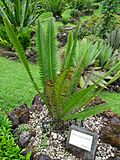 |
Dioon angustifolium Miq. | Nuevo León, Tamaulipas (Mexico) |
| Dioon argenteum T.J.Greg. & al. | Oaxaca (Mexico) | |
 |
Dioon califanoi De Luca & Sabato | Puebla, Oaxaca (Mexico) |
 |
Dioon caputoi De Luca, Sabato & Vázq.Torres | Puebla, Oaxaca (Mexico) |
 |
Dioon edule Lindl. | Nuevo León, Tamaulipas, Veracruz, Guanajuato, Chiapas, Hidalgo, Mexico State, Querétaro, San Luis Potosí (Mexico) |
 |
Dioon holmgrenii De Luca, Sabato & Vázq.Torres | Oaxaca (Mexico) |
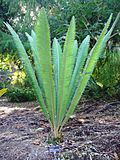 |
Dioon mejiae Standl. & L.O.Williams | Honduras |
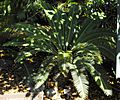 |
Dioon merolae De Luca, Sabato & Vázq.Torres | Oaxaca, Chiapas (Mexico) |
| Dioon oaxacensis Gutiérrez-Ortega, Pérez-Farrera & Vovides | Oaxaca (Mexico) | |
| Dioon planifolium Salas-Morales, Chemnick & Gregory | Oaxaca (Mexico) | |
| Dioon salas-moralesiae Gutiérrez-Ortega & Pérez-Farrera | Chiapas (Mexico) | |
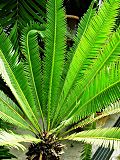 |
Dioon purpusii Rose | Oaxaca (Mexico) |
 |
Dioon rzedowskii De Luca, Sabato & Vázq.Torres | Oaxaca (Mexico) |
| Dioon sonorense (De Luca, Sabato & Vázq.Torres) Chemnick et al. | Sonora, Sinaloa (Mexico) | |
 |
Dioon spinulosum Dyer ex Eichl | Veracruz, Oaxaca (Mexico) |
| Dioon stevensonii Nic.-Mor. & Vovides | Michoacán, Guerrero (Mexico) | |
 |
Dioon tomasellii De Luca, Sabato & Vázq.Torres | Durango, Jalisco, Nayarit (Mexico) |
| Dioon vovidesii Gutiérrez-Ortega & Pérez-Farreras | Veracruz (Mexico) |
How People Use Dioon Plants
In Honduras, people pick the female cones of D. mejiae to get the seeds. About 33,000 local people use these seeds to make traditional foods like tamales or tortillas, as a replacement for cornmeal. The leaves of Dioon plants are also traditionally used on Palm Sunday.
Images for kids
See also
 In Spanish: Dioon para niños
In Spanish: Dioon para niños





